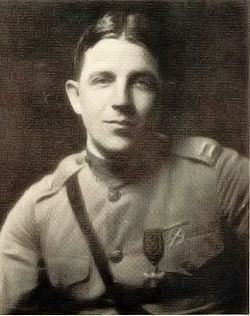Name Laurence Stallings | ||
 | ||
Born Laurence Tucker StallingsNovember 25, 1894Macon, Georgia ( 1894-11-25 ) Occupation Playwright, Novelist, Screenwriter Notable works PlumesWhat Price Glory Died February 28, 1968, Pacific Palisades, California, United States Spouse Helen Poteat (m. 1919–1936) Children Sally Stallings, Diana Poteat Stallings, Laurence Stallings, Jr., Sylvia Stallings Books Plumes, The Doughboys: The Story of the American Expeditionary Forces 1917-1918 Movies The Big Parade, She Wore a Yellow Ribbon, 3 Godfathers, Northwest Passage, Jungle Book Similar People Frank Nugent, Maxwell Anderson, Winton Hoch, Harry Behn, James Warner Bellah | ||
Laurence Tucker Stallings (November 25, 1894 - February 28, 1968) was an American playwright, screenwriter, lyricist, literary critic, journalist, novelist, and photographer. Best known for his collaboration with Maxwell Anderson on the 1924 play What Price Glory, Stallings also produced a groundbreaking autobiographical novel, Plumes, about his service in World War I, and published an award-winning book of photographs, The First World War: A Photographic History.
Contents
Life
Stallings was born Laurence Tucker Stallings in Macon, Georgia, to Larkin Tucker Stallings, a bank clerk, and Aurora Brooks Stallings, a homemaker and avid reader who inspired her son's love of literature. He entered Wake Forest University in North Carolina in 1912 and became the editor of the campus literary magazine, the Old Gold and Black.
He met Helen Poteat while at Wake Forest. She was the daughter of Dr. William Louis Poteat, the university president, and the sister of Stallings's classics professor. They were sweethearts throughout their school years. He graduated from Wake Forest College in 1916, and got a job writing advertising copy for a local recruiting office. He was so convinced by his own prose, he joined the United States Marine Reserve in 1917. He left Philadelphia for overseas duty in France aboard the USS Henderson on 24 April 1918. In France, he served as a platoon commander with 3rd Battalion, 5th Marines during the fighting at Château-Thierry. He was wounded in the leg in the Battle of Belleau Wood after charging an enemy machine-gun nest on 25 June. After begging the doctors not to amputate, he went home to spend two painful years recuperating at the Brooklyn Naval Hospital. He later damaged it with a fall on the ice, and it was amputated in 1922. Many years later, he had to have his remaining leg amputated, as well. After finishing his convalescence, Stallings and Poteat married on March 8, 1919; they had two daughters, Sylvia (born 1926) and Diana (born 1931), before divorcing in 1936. In 1928-1929, they restored Poteat House near Yanceyville, North Carolina. Through Helen his aunt by marriage was the painter Ida Isabella Poteat.
The year following his divorce, Stallings married Louise St. Leger Vance, his secretary at Fox Studios. They had two children, Laurence, Jr. (born 1939) and Sally (born 1941). Stallings died of a heart attack in Pacific Palisades, California. He was buried with full military honors at Fort Rosecrans National Cemetery in Point Loma near San Diego.
Career
Stallings received a Master of Science degree from Georgetown University, after which he worked as a reporter, critic, and entertainment editor at the New York World. He was impressed by Maxwell Anderson's first play, White Desert, and the two joined forces to collaborate on What Price Glory, which opened at the Plymouth Theatre in New York City in 1924. The critically acclaimed play ran for 435 performances and spawned two film adaptations.
The two went on to co-write the plays The First Flight and The Buccaneer, both in 1925. Stallings continued his theatre career with the book and lyrics for the musical Deep River (1926), adapted Ernest Hemingway's novel A Farewell to Arms for the stage in 1930, co-wrote the book for the musicals Rainbow (1928) with Oscar Hammerstein, and Virginia (1937) with Owen Davis, and penned the play The Streets Are Guarded in 1944. He was a member of the Algonquin Round Table.
Stallings' novel, the autobiographical Plumes, was published in 1924 and was a huge success, with nine printings in that year alone. It was adapted into King Vidor's The Big Parade, which was quite successful and remained MGM's largest-grossing film until Gone with the Wind in 1939. He was regarded as a key influence on three of John Ford's greatest films, serving as writer or co-writer for 3 Godfathers, She Wore a Yellow Ribbon, and The Sun Shines Bright. Additional screenwriting credits included Northwest Passage, The Man from Dakota, and On Our Merry Way.
Stalling's last book, The Doughboys: The Story of the AEF, 1917-1918, was published in 1963. The nonfiction account of World War I partly explores the racism and discrimination faced by the black troops during the war. Stallings was recalled up to service with the U.S. Marine Corps during World War II as a lieutenant colonel, but did not serve overseas.
